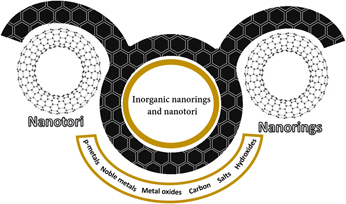Published online by Cambridge University Press: 09 December 2019

Toroidal (ring-like) structures are common in organic chemistry, but at the nanoscale level, the inorganic nanorings and nanotori are limited and represented mainly by carbon, several p- and noble metals (Ag, Au, Al, and Au/Co/Au), metal and nonmetal oxides (ZnO, MoO2, Fe2O3, and SiO2), hydroxides (Co(OH)2), and salts (PbI2 and metal selenides), and some combinations of carbon nanotori with fullerenes and carbon chains, as well as doped nanorings, are known. The nanotori are closely related to ball-type nanostructures as nano-onions, nanoballs, and nanospheres. Despite their relative low existence, they possess several useful properties and respective applications as isolators, sensors, optoelectronics, as traps for atoms and ions, and counterparts in lubricants, thus causing a certain interest in their development. The properties of nanotori have been studied mainly by DFT calculations. Several nanorings possess stabilities up to 3000 K before unfolding, multiresonant properties and magneto–optical activity, paramagnetism, and ferromagnetism. The carbon nanorings are studied considerably better, being compared with other compounds. This review summarizes the state of the art of all available inorganic toroidal nanostructures, believing that a considerable higher number of inorganic systems might be prepared in this form, taking into account their unusual properties.
This section of Journal of Materials Research is reserved for papers that are reviews of literature in a given area.